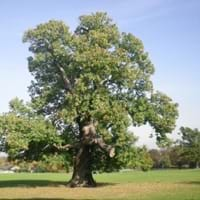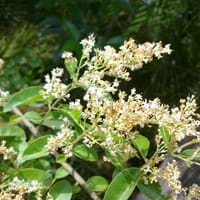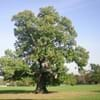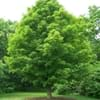Life Span
Perennial
Perennial
Type
Tree
Broadleaf Evergreen
Origin
Eastern Asia
China
Types
Not Available
Ligustrum sinense concavum, Ligustrum sinense coryanum, Ligustrum sinense dissimile
Number of Varieties
Not Available
Habitat
Temperate Regions
Not Available
USDA Hardiness Zone
6-8
8-10
AHS Heat Zone
8-2
Not Available
Sunset Zone
A3, 2a, 2b, 3a, 3b, 4, 5, 6, 7, 8, 9, 10, 12, 14, 15, 16, 17, 18, 19, 20, 21, 22, 23, 24
21,22
Habit
Oval or Rounded
Upright/Erect
Flower Color
Red, Purple
White
Flower Color Modifier
Bicolor
Bicolor
Fruit Color
Red, Green
Dark Blue, Black
Leaf Color in Spring
Green, Light Green
Dark Green
Leaf Color in Summer
Green
Dark Green
Leaf Color in Fall
Yellow, Gold
Dark Green
Leaf Color in Winter
Not Available
Dark Green
Leaf Shape
Oblong or Lanceolate
Ovate
Plant Season
Spring, Summer, Fall, Winter
Spring, Summer, Fall, Winter
Sunlight
Full Sun, Partial Sun, Partial shade
Full Sun, Partial Sun, Partial shade
Growth Rate
Slow
Very Fast
Type of Soil
Clay, Loam, Sand
Loam, Sand
The pH of Soil
Acidic, Neutral, Alkaline
Acidic, Neutral, Alkaline
Soil Drainage
Well drained
Average
Tolerances
Shade areas
Pollution, Drought, Salt
Where to Plant?
Ground
Ground
How to Plant?
Grafting, Seedlings
Cuttings
Plant Maintenance
Medium
Medium
Watering Requirements
Average Water Needs
Keep the ground moist but not water-logged
In Summer
Lots of watering
Lots of watering
In Spring
Moderate
Moderate
In Winter
Average Water
Average Water
Soil pH
Acidic, Neutral, Alkaline
Acidic, Neutral, Alkaline
Soil Type
Clay, Loam, Sand
Loam, Sand
Soil Drainage Capacity
Well drained
Average
Sun Exposure
Full Sun, Partial Sun, Partial shade
Full Sun, Partial Sun, Partial shade
Pruning
Remove damaged leaves, Remove dead branches, Remove dead leaves
Prune in spring
Fertilizers
All-Purpose Liquid Fertilizer
Fertilize just before the growing season begins
Pests and Diseases
Fungal Diseases, Squirrels
Not Available
Plant Tolerance
Drought
Drought, Pollution, Salt
Flowers
Insignificant
Showy
Flower Petal Number
Single
Single
Foliage Texture
Fine
Medium
Foliage Sheen
Matte
Glossy
Attracts
Not Available, Squirrels
Birds
Allergy
Oral Allergy, Throat itching
Not Available
Aesthetic Uses
Beautification, Landscape Designing
Showy Purposes, small hedge
Beauty Benefits
Not Available
Not Available
Environmental Uses
Air purification
Air purification
Medicinal Uses
Potassium, Rich in Iron, Vitamin A, Vitamin B, Vitamin C
Not Available
Part of Plant Used
Seeds
Whole plant
Other Uses
Food for animals, Used as a nutritious food item, Used As Food, Used for its medicinal properties, Used for Landscaping
Used as Ornamental plant
Used As Indoor Plant
No
No
Used As Outdoor Plant
Yes
Yes
Garden Design
Container, Feature Plant, Foundation, Mixed Border, Rock Garden / Wall, Topiary / Bonsai / Espalier
Feature Plant, Hedges, Screening, Wind Break, Street Trees
Botanical Name
Castanea sativa
Ligustrum sinense
Common Name
Sweet Chestnut, Chestnut
Chinese privet
In Hindi
शाहबलूत का फल
Chinese privet
In German
Esskastanie
Chinesischer Liguster
In French
châtaignier
Chinese privet
In Spanish
Castaña dulce
aligustrina, ligustrina, ligustrín, o aligustre
In Greek
Sweet Chestnut
Κινέζοι privet
In Portuguese
Castanheiro
Ligustrina
In Polish
słodki Chestnut
Chiński ligustr
In Latin
Dulce Chestnut
Chinese privet
Phylum
Magnoliophyta
Magnoliophyta
Class
Magnoliopsida
Magnoliopsida
Order
Sapindales
Scrophulariales
Family
Aceraceae
Oleaceae
Clade
Angiosperms, Eudicots, Rosids
Angiosperms, Asterids, Eudicots
Tribe
Not Available
Oleeae
Subfamily
Not Available
Not Available
Number of Species
Not Available
Importance of Sweet Chestnut and Chinese Privet
Want to have the most appropriate plant for your garden? You might want to know the importance of Sweet Chestnut and Chinese Privet. Basically, these two plants vary in many aspects. Compare Sweet Chestnut and Chinese Privet as they differ in many characteristics such as their life, care, benefits, facts, etc. Every gardener must at least have the slightest clue about the plants he wants to plant in his garden. Compare their benefits, which differ in many ways like facts and uses. The medicinal use of Sweet Chestnut is Potassium, Rich in Iron, Vitamin A, Vitamin B and Vitamin C whereas of Chinese Privet is Not Available. Sweet Chestnut has beauty benefits as follows: Not Available while Chinese Privet has beauty benefits as follows: Not Available.
Compare Facts of Sweet Chestnut vs Chinese Privet
How to choose the best garden plant for your garden depending upon its facts? Here garden plant comparison will help you to solve this query. Compare the facts of Sweet Chestnut vs Chinese Privet and know which one to choose. As garden plants have benefits and other uses, allergy is also a major drawback of plants for some people. Allergic reactions of Sweet Chestnut are Oral Allergy and Throat itching whereas of Chinese Privet have Not Available respectively. Having a fruit bearing plant in your garden can be a plus point of your garden. Sweet Chestnut has showy fruits and Chinese Privet has no showy fruits. Also Sweet Chestnut is not flowering and Chinese Privet is not flowering . You can compare Sweet Chestnut and Chinese Privet facts and facts of other plants too.





